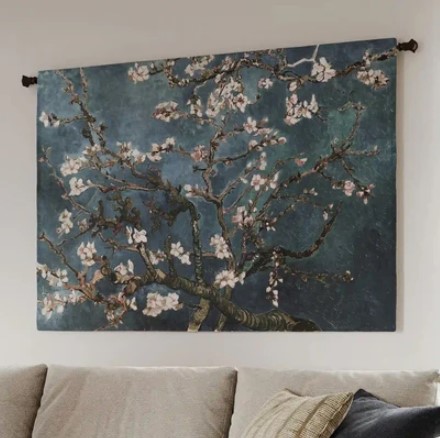
Woven throw blankets have long been a staple in homes for both their comfort and visual appeal. With their rich textures and intricate patterns, they offer more than warmth—they tell stories of craftsmanship, heritage, and artistry. But how exactly are woven throw blankets made? From the raw materials to the final touch in your living room, this article takes you through the journey of a woven throw, and how it even intersects with trends like woven wall hangings and hanging woven wall decor.
The Origins: Material Selection
Every woven throw blanket begins with the selection of fibers. Common materials include cotton, wool, acrylic, and blends that combine the durability of synthetic fibers with the softness of natural ones. Cotton is favored for its breathability and ease of care, while wool is prized for its insulating properties. Some artisanal brands even incorporate recycled materials or ethically sourced fibers to appeal to eco-conscious consumers.
Before the weaving process starts, the raw fibers are cleaned, carded, and spun into yarn. This yarn can be dyed beforehand (pre-dyeing) or after weaving, depending on the desired effect. Natural dyes and low-impact chemical dyes are often used by sustainable manufacturers to reduce environmental impact.
The Loom: Heart of the Weaving Process
Once the yarn is ready, it’s time for the weaving process, the core of what makes these blankets “woven.” Traditional weaving is done on a loom, a device that interlaces warp (vertical) and weft (horizontal) threads to form fabric. There are several types of looms used, including handlooms and power looms.
Handloom weaving is a time-intensive, skilled craft often performed by artisans. Each piece is woven manually, allowing for intricate patterns and unique variations. This is commonly found in regions with strong textile traditions, such as India, Peru, and parts of Africa. Power looms, on the other hand, are used in large-scale manufacturing and can produce multiple blankets quickly with consistent quality.
Weaving Techniques and Patterns
Woven throw blankets come in a variety of patterns, textures, and finishes. Some common techniques include:
-
Twill Weave: Recognized by its diagonal lines, this method creates a strong and flexible fabric.
-
Jacquard Weave: This complex style allows for detailed designs and is often used for more decorative blankets.
-
Plain Weave: The simplest and most common, resulting in a uniform, balanced texture.
Each technique influences the appearance and feel of the final product. Jacquard looms, in particular, enable the creation of intricate motifs that can resemble art pieces—an aesthetic that connects closely to woven wall hangings and hanging woven wall decor.
Finishing Touches
After the blanket is woven, it goes through finishing processes to enhance its look and feel. These include:
-
Washing and Softening: To remove any residues and soften the fabric.
-
Brushing: Sometimes used to raise fibers for a fluffier texture.
-
Trimming and Fringing: Adding decorative edges, tassels, or fringes.
Some woven throw blankets are also pre-shrunk or treated to be more stain-resistant. Artisanal pieces might be finished by hand, ensuring that each blanket carries a touch of the maker’s personality.
Quality Control and Packaging
Before heading to stores or online shops, the blankets undergo quality control checks. This includes evaluating the weave consistency, color fastness, and edge durability. Blankets that pass these standards are folded, tagged, and packaged—ready to be shipped to homes around the world.
From Utility to Decor: Blurring the Lines
Today, woven throw blankets are not just functional items. They’re integral parts of home aesthetics. Drape one over a couch to add a pop of color, fold it neatly at the foot of a bed for texture, or even repurpose it as wall decor.
This crossover into design is what connects woven throw blankets with woven wall hangings. Both rely on the same weaving principles, but serve different purposes. Hanging woven wall decor often uses similar patterns and materials, yet is designed purely for visual impact. Many people even use small woven throws as statement pieces on walls, blending function with art.
Sustainability and Ethical Craftsmanship
A growing number of consumers are seeking products that are not only beautiful but also ethically made. Many brands now highlight transparency in sourcing and labor practices. Supporting companies that work with traditional weavers or co-ops ensures that your blanket doesn’t just warm your home—it supports global artisan communities.
Eco-friendly woven throw blankets often come with tags detailing their origin, the type of dyes used, and the social impact of your purchase. This transparency has become a key selling point in today’s values-driven marketplace.
Conclusion
From the careful selection of yarn to the rhythmic dance of threads on a loom, woven throw blankets are the result of both tradition and innovation. They travel from artisan hands or modern mills to become cherished elements in our living spaces. Whether used for comfort, style, or storytelling, these blankets are much more than fabric—they’re functional art. And as trends continue to embrace tactile, crafted aesthetics, we’ll see even more crossover between woven throw blankets and other design elements like woven wall hanging decor.